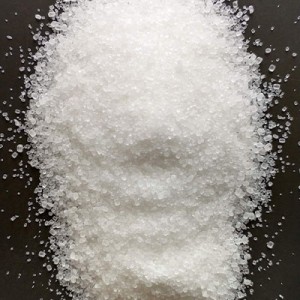Industrial grade application of monoammonium
Unleash the potential of your agricultural and industrial applications with our premium, technical grade monoammonium phosphate (MAP). As a major source of phosphorus (P) and nitrogen (N), MAP is an important component of the fertilizer industry and is known for its high phosphorus content, making it the most effective solid fertilizer.
Our MAP are carefully manufactured to meet the stringent standards required for industrial applications, ensuring you receive a product that not only improves crop yields but also supports sustainable agricultural practices. With its unique formula, MAP promotes healthy plant growth, improves nutrient uptake and improves soil fertility, making it an indispensable asset for farmers and agricultural businesses.
Whether you are looking to increase agricultural yields or find a reliable source of nutrients for industrial applications, our industrial grade monoammonium phosphate is the solution you need. Experience the changes that high-quality MAP brings to your operations.

1. Known for its rich phosphorus (P) and nitrogen (N) content, MAP is a cornerstone of the agricultural sector, especially for its industrial-level applications.
2. Monoammonium phosphate is not just another fertilizer; It is the power source with the highest phosphorus content among common solid fertilizers. This makes it an important component in promoting healthy plant growth, enhancing root development and increasing overall crop yields. Its unique formula effectively absorbs nutrients, ensuring plants get the elements they need for optimal growth.
3. Industrial-grade applications of monoammonium phosphate are particularly beneficial for large-scale agricultural operations. Its versatility allows it to be used on a variety of crops, from cereals to fruits and vegetables. By incorporating MAP into fertilization plans, farmers can achieve better nutrient management, thereby increasing productivity and sustainability.
1. High Nutrient Content: MAP contains the highest concentration of phosphorus among common solid fertilizers, making it an effective choice for crops that require large amounts of phosphorus for root development and flowering.
2. VERSATILITY: Its solubility in water allows it to be easily applied in a variety of agricultural settings, whether by broadcast, striping or fertigation.
3. Increase Crop Yield: The balanced nutritional content of MAP promotes healthy plant growth, thereby increasing crop yield and improving product quality.
4. Compatibility: MAP can be blended with other fertilizers to enhance its effectiveness in customized fertilization plans.
1. Cost: While monoammonium phosphate fertilizer is effective, it can be more expensive than other phosphorus sources, which may deter some farmers, especially in developing areas.
2. Soil pH Impact: Over time, the use of MAP can cause soil acidification, which may require additional lime applications to maintain optimal pH levels.
3. Environmental Issues: Excessive use of monoammonium phosphate can lead to the loss of nutrients and lead to water quality problems such as algae blooms.
1. Agriculture: Farmers use MAP to enhance soil fertility and increase crop yields. Its rapid solubility allows plants to quickly absorb nutrients, making it the first choice for many agricultural practices.
2. Horticulture: In horticulture, MAP is used to promote healthy plant growth, especially flowering plants and vegetables.
3. Mixed Fertilizers: MAP is often blended with other fertilizers to create a customized nutrient solution suited to specific crop needs.
4. Industrial Uses: In addition to agriculture, MAP has applications in a variety of industrial processes, including food production and animal feed.
Q1: What are the benefits of using MAP?
A: MAP provides essential nutrients that promote plant growth, improve soil health, and increase crop yields.
Q2: Is MAP safe for the environment?
A: When used as directed, MAP is safe and effective for agricultural use and contributes to sustainable agricultural practices.






